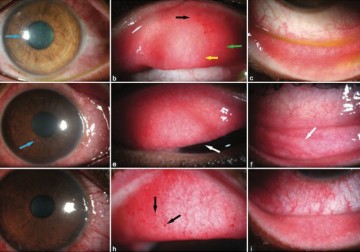A study by Dr Himanshu Behera and others from L V Prasad Eye Institute analyses the tear secretion of conjunctivitis patients to determine the presence of the SARS-CoV-2 virus in tear samples. The study was conducted during the third pandemic wave in December 2021.
COVID-19 is a respiratory disease caused by the SARS-COV-2 virus. The condition causes respiratory dysfunction, and its primary mode of transmission is respiratory droplets in the air, expelled when a person coughs or sneezes. Ocular surfaces exposed to such infected aerosol particles may be a point of entry for the virus and result in localized infections, such as keratoconjunctivitis. Reported symptoms include redness and watery discharge, and the conjunctivitis may be self-limiting. The conjunctiva seems to be more susceptible for a SARS-CoV-2 infection, perhaps because of the higher expression of ACE2 receptors that bind with the virus. What other ocular features host enough viral load that can be tested for infection and transmission?
Tears present an opportunity to test for the presence of SARS-COV-2 virus. Previous studies have detected the virus in the conjunctiva, where a subset of infected individuals presented with conjunctivitis. These tests have used conjunctival swabs and ran them through an RT PCR test to detect viral load. The RT PCR test is, in fact, widely accepted for detecting a COVID-19 infection using nasopharyngeal samples. However, ocular samples do not enjoy the same success with RT PCR. This is especially true for tear samples where the viral load is too little for the test to identify.
A new paper in the Indian Journal of Ophthalmology analyses the presence of SARS-COV-2 virus in the tear secretion of conjunctivitis patients and identifies a positive subset using tear samples to run an RT PCR test. The study included 111 patients (74% males), with varying inflammation from mild-moderate to severe conjunctival congestion. Tear samples were collected using Schrimer’s strips and capillary tubes. 5 patients (4.3%) were found to be positive for SARS-CoV-2 infection.
The study found that all the 5 positive samples were collected using the capillary tube—the authors note that this method presents a better choice for sample tear collection. The authors underscore the need for ophthalmic personnel to exercise caution while examining patients with conjunctivitis.
'The SARS‑CoV‑2 viral shedding was detected in apparently healthy conjunctivitis patients. Though the prevalence was less, still, it cannot be ignored. Appropriate COVID-19‑preventive behavior should be followed in ocular settings to reduce the spread of virus,' says Dr Himansu Behera, corresponding author of this paper and Scientist, Ocular Microbiology Service, LVPEI.
Citation
Behera HS, Ghana M, Parida P, Sahu SK, Das S, Priyadarshini SR, et al. Assessment of SARS-CoV-2 virus in the tear secretion of conjunctivitis patients during COVID-19 pandemic. Indian J Ophthalmol 2023;71:70-4.
Photo credit: Figure 1, Describes the diffuse illumination frontal view and lower tarsal conjunctiva of cases, Behera et al.



